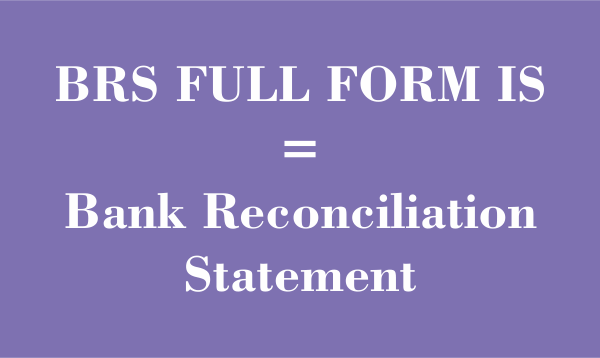A bank reconciliation statement (BRS) is a document that compares the balance of a company’s bank account with its own accounting records. It is used to identify any discrepancies between the two balances and to reconcile them.
Introduction

Imagine you’re a financial detective, trying to make sure all your money transactions add up and nothing goes missing. That’s essentially what a Bank Reconciliation Statement (BRS) does for your finances.
In simple terms, a Bank Reconciliation Statement is like a checkpoint for your bank account. It’s a way to compare your own record of transactions (usually in your cash book) with your bank’s record (your bank statement). Why? Because sometimes, they don’t match perfectly due to various reasons.
Let’s break it down: you might have written a check that hasn’t been cashed by the person you gave it to, or maybe you deposited cash that hasn’t shown up in your bank statement yet. These differences can make your records and the bank’s records out of sync.
The goal of a Bank Reconciliation Statement is to find and explain these differences, ensuring both your records and the bank’s records align correctly. It’s about making sure your money is where you think it is and accounting for every penny.
Bank Transactions and Accounting Records
| # | Transaction Type | Description |
|---|---|---|
| 1 | Deposits | Money you add to your bank account, such as cash deposits, checks, or electronic transfers. |
| 2 | Withdrawals | Funds you take out of your account, either through ATM withdrawals, checks, or electronic transfers to others. |
| 3 | Checks Issued | Checks you’ve written to pay for goods, services, or to transfer funds to another account. |
| 4 | Debit Card Usage | Transactions made using a debit card linked to your bank account, which deduct funds directly. |
| 5 | Bank Fees and Charges | Any fees or charges imposed by the bank for services provided, like maintenance fees, overdraft charges, etc. |
| 6 | Interest Earned | Interest credited to your account by the bank, typically from savings accounts, CDs, or other interest-bearing deposits. |
| 7 | Electronic Fund Transfers (EFTs) | Automated payments, transfers, or bill payments made electronically, often scheduled on a regular basis. |
| 8 | Reversals and Adjustments | Corrections or adjustments made by the bank, often due to errors or disputed transactions. |
Differences Between Bank Statement and Cash Book
Imagine your financial life is a story, and both the Bank Statement and Cash Book are important chapters. They both tell the tale of your money but from different perspectives.
Bank Statement:
Imagine your Bank Statement as the official recordkeeper, sort of like a financial referee. It’s a document that your bank provides, summarizing all the transactions related to your bank account over a specific period. This includes deposits, withdrawals, fees, interest, and more. The bank independently maintains and updates this record based on their perspective of your account activity. Think of it as the ‘official version’ of your financial story, verified by the bank.
Cash Book:
On the other hand, your Cash Book is like your personal diary. It’s where you record every financial move you make, whether it’s putting money into your account (deposits) or taking it out (withdrawals). It’s your view of the financial story, capturing your day-to-day transactions. However, it might not always align perfectly with the bank’s version because there could be transactions that you’ve recorded but the bank hasn’t processed yet, or vice versa.
Steps to Prepare a Bank Reconciliation
| # | Step | Description |
|---|---|---|
| 1 | Collect Statements | Gather the latest bank statement from the bank and your own Cash Book (or bank account record). |
| 2 | Compare Opening Balances | Match the opening balance of your bank statement with the opening balance of your Cash Book. Note any differences. |
| 3 | List Deposits in Transit | Identify any deposits made but not yet reflected in the bank statement. Record these as ‘Deposits in Transit’. |
| 4 | List Outstanding Checks | Identify any checks issued but not yet cleared by the bank. Record these as ‘Outstanding Checks’. |
| 5 | Identify Bank Charges and Fees | Check for any bank charges or fees listed in the bank statement that are not recorded in your Cash Book. Record these as ‘Bank Charges’. |
| 6 | Identify Interest Earned | Check for any interest earned on your account that is listed in the bank statement but not recorded in your Cash Book. Record this as ‘Interest Earned’. |
| 7 | List Unpresented Deposits | Identify any deposits recorded in your Cash Book but not appearing in the bank statement. Record these as ‘Unpresented Deposits’. |
| 8 | Adjust for Errors | Check for any errors in recording transactions in either the Cash Book or the bank statement. Correct these errors. |
| 9 | Calculate Adjusted Cash Book Balance | Adjust the Cash Book balance by considering the identified differences and errors. |
| 10 | Reconcile Bank Statement Balance | Add ‘Deposits in Transit’, ‘Unpresented Deposits’, and ‘Interest Earned’ to the bank statement’s ending balance. Deduct ‘Outstanding Checks’, ‘Bank Charges’, and any other relevant deductions. |
Common Discrepancies and Adjustments
1. Outstanding Checks:
- Description: These are checks you’ve written and recorded in your Cash Book, but the recipients haven’t cashed them yet, so they don’t appear on your bank statement.
- Adjustment: Deduct the total amount of outstanding checks from your bank statement balance.
2. Deposits in Transit:
- Description: Deposits you’ve made that haven’t been added to your bank statement because they are still being processed by the bank.
- Adjustment: Add the total amount of deposits in transit to your bank statement balance.
3. Bank Charges and Fees:
- Description: Fees or charges applied by the bank for various services, which may not be recorded in your Cash Book.
- Adjustment: Deduct the total amount of bank charges and fees from your bank statement balance.
4. Unpresented Deposits:
- Description: These are deposits recorded in your Cash Book but have not yet appeared on your bank statement.
- Adjustment: Deduct the total amount of unpresented deposits from your Cash Book balance.
5. Interest Earned:
- Description: Interest earned on your account that is credited by the bank but not yet recorded in your Cash Book.
- Adjustment: Add the total amount of interest earned to your bank statement balance.
Benefits of Regular Bank Reconciliation
| # | Benefit | Description |
|---|---|---|
| 1 | Accuracy Assurance | Ensures that your financial records align with the bank’s records, minimizing errors and discrepancies. |
| 2 | Fraud Detection | Helps in identifying unauthorized transactions or potential fraudulent activities, enhancing financial security. |
| 3 | Cash Flow Management | Provides a clear understanding of your actual cash position, aiding better financial planning and management. |
| 4 | Financial Discipline | Encourages maintaining organized and accurate financial records, promoting responsible financial habits. |
| 5 | Discrepancy Resolution | Enables timely identification and resolution of discrepancies, preventing potential financial issues. |
| 6 | Financial Health Check | Offers a regular review of your financial standing and allows for proactive decision-making based on accurate data. |
| 7 | Credibility and Trust | Enhances the credibility of financial statements, instilling trust in stakeholders like investors, creditors, or auditors. |
| 8 | Legal Compliance | Assists in complying with financial regulations and requirements set forth by governing bodies. |
| 9 | Improved Decision-making | Provides a foundation of accurate financial information for making sound financial decisions. |
| 10 | Efficient Reconciliation | Reduces the time and effort required for periodic reconciliation by addressing discrepancies promptly. |
Conclusion
A Bank Reconciliation Statement is not just a financial exercise; it’s a vital tool for maintaining financial accuracy and integrity. By comparing your Cash Book with the Bank Statement, you’re essentially cross-verifying the financial story told by both you and your bank. This reconciliation process helps unearth discrepancies, errors, and potential fraud, providing an accurate and real-time view of your financial health.
The benefits are manifold: from ensuring financial accuracy, detecting fraud, and managing cash flow to fostering financial discipline and aiding decision-making. It’s a fundamental practice in financial management that not only enhances credibility but also ensures compliance with legal and regulatory standards.
FAQs
A Bank Reconciliation Statement (BRS) is a document that compares an individual’s or a business’s Cash Book (their own record of transactions) with the Bank Statement (the bank’s record of transactions) to identify any discrepancies and ensure accuracy in financial records.
Bank Reconciliation is crucial for verifying the accuracy of financial records, detecting errors, uncovering potential fraud, managing cash flow effectively, ensuring compliance with financial regulations, and maintaining trust with stakeholders.
It is recommended to perform Bank Reconciliation monthly or at least quarterly to maintain financial accuracy and promptly identify and rectify any discrepancies.
Common discrepancies include outstanding checks (checks not yet cashed), deposits in transit (deposits not yet recorded by the bank), bank charges, unpresented deposits, interest earned, and recording errors.
Read Also
Related posts:
- AMC Full Form: Benefits, Components, Needs, Advantage
- ORS Full Form: Dehydration, Myths, Flavors, Varieties & Facts
- PCC Full Form: Importance, Types, Application Process
- PAN Full Form: Legal Provisions, Regulations,
- BRB Full Form: Productive, Routine, Distractions
- MCD Full From: Introduction, Responsibility, Challenges
- CT Scan Full Form: Scans, price, Advantages
- USA Full Form: History, Economics,Technology, culture




















